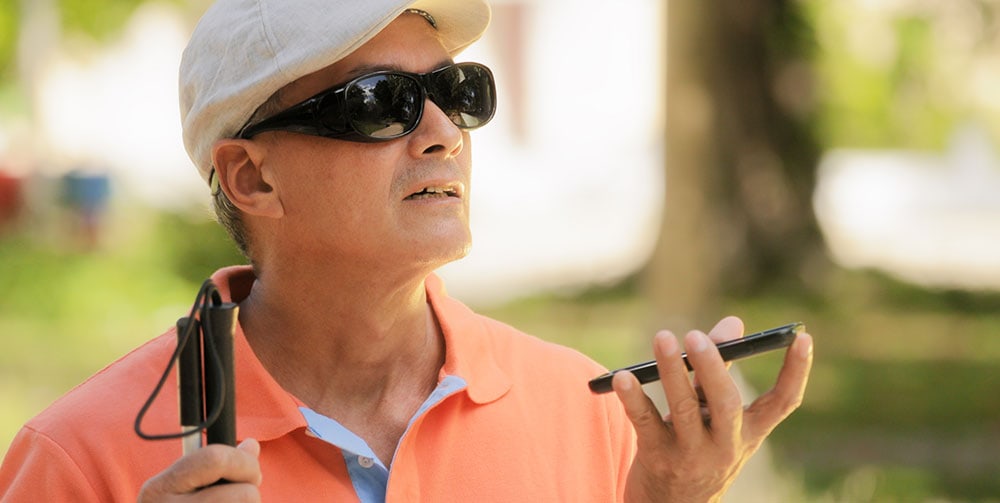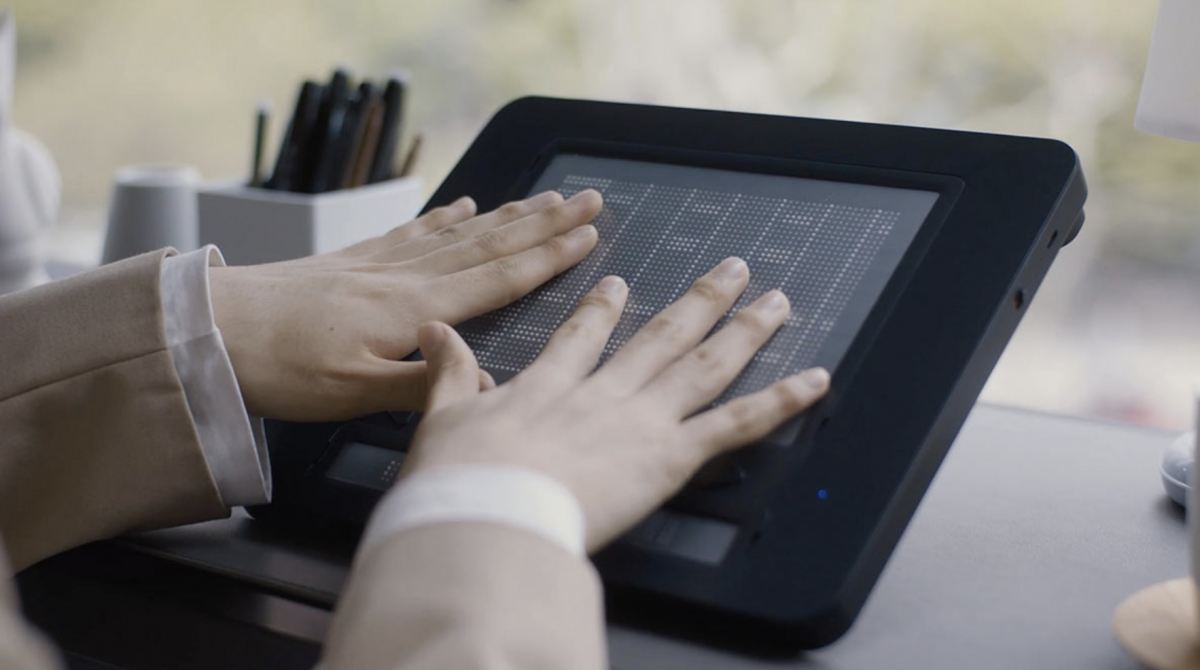Braille Displays and Notetakers: Key Tools for Learning and Work
Wiki Article
Discover Ingenious Devices Designed for the Aesthetically Damaged
The development of innovative devices for the aesthetically impaired represents a substantial improvement in ease of access and independence. Technologies such as clever glasses with AI abilities and mobile applications developed to give auditory descriptions are reshaping everyday experiences for individuals. In addition, wearable gadgets that use haptic feedback boost ecological awareness, while contemporary Braille technologies use brand-new means to engage with text. As these devices remain to evolve, their impact on the lives of those with visual problems increases essential inquiries regarding the future of inclusivity and autonomy in numerous aspects of life. What lies ahead in this technical landscape?Smart Glasses for Navigating

Smart glasses made for navigation are revolutionizing the method aesthetically damaged people interact with their setting. These innovative devices make use of a combination of cam modern technology, man-made knowledge, and acoustic responses to provide real-time information regarding surroundings. By utilizing obstacle detection systems, wise glasses can inform customers to possible threats, allowing more secure wheelchair in both familiar and unfamiliar settings.
The assimilation of GPS innovation additionally enhances navigating abilities, permitting individuals to get acoustic directions as they relocate. This hands-free approach not only fosters self-reliance but additionally equips aesthetically damaged people to browse city landscapes with raised confidence. Furthermore, many clever glasses are furnished with functions that recognize sites and road indications, providing contextual information that boosts the user experience.
Additionally, the advancement of these devices is continually advancing, with business functioning to enhance the accuracy of object acknowledgment and increase the series of navigational features. As smart glasses end up being extra budget-friendly and available, they hold the possible to dramatically change everyday life for visually damaged individuals. Eventually, these innovative devices represent a vital action towards inclusivity, offering enhanced movement and a higher sense of freedom for people navigating the globe around them.

Mobile Application for Daily Living
Just how can mobile applications boost the day-to-day lives of aesthetically damaged people? Mobile applications are transforming the means aesthetically impaired individuals navigate their environments, handle everyday jobs, and access information. These applications supply vital assistance via different functionalities, cultivating independence and improving quality of life.Several innovative mobile apps are designed specifically for daily living. Apps like Be My Eyes connect aesthetically impaired individuals with sighted volunteers through video telephone calls, permitting them to obtain real-time support with tasks such as checking out tags or navigating unknown spaces. Likewise, Seeing AI, established by Microsoft, makes use of fabricated intelligence to explain surroundings, checked out message, and identify items, successfully transforming a smartphone right into an effective device for everyday aid.
Furthermore, navigating apps customized for the aesthetically impaired, such as Aira and BlindSquare, provide audio-based directions and ecological information, enabling users to traverse their environments safely and with confidence. Beyond navigation and instant assistance, mobile applications likewise sustain organization and task monitoring, with features that assist users establish reminders, create to-do checklists, and track consultations. In summary, mobile applications act as essential resources, equipping aesthetically damaged people to lead even more independent and meeting lives.
Wearable Technologies for Support
Empowerment through technology is progressively noticeable in the world of wearable tools created to assist aesthetically impaired individuals. These innovative tools integrate effortlessly into day-to-day live, enhancing navigating and supplying vital comments to individuals. Wise glasses furnished with electronic cameras can recognize faces and review message out loud, enabling individuals to engage even more with confidence in social and professional settings.One more notable innovation is using haptic responses systems in wearable devices. These systems utilize vibrations or various other tactile signals to communicate info about the individual's setting, such as obstacles or modifications in surface, boosting wheelchair and safety and security. Wearable technologies additionally consist of wristbands that connect to mobile phones, informing individuals to alerts with refined vibrations, therefore enhancing connectivity without dependence on visual hints.
As these technologies proceed to advance, they are not just improving independence for aesthetically damaged individuals however additionally fostering a higher sense of inclusion in culture. By linking the gap between obstacles dealt with in daily living and the possibility for autonomy, wearable innovations function as crucial tools in the mission for equality and empowerment for those with visual problems.
Audio Description Tools
Sound summary tools play a vital duty in enhancing access for aesthetically damaged individuals, providing them with the capacity to engage with aesthetic media. Voice-activated assistive devices. These devices supply narrated summaries of key aesthetic aspects in films, tv programs, and live efficiencies, ensuring that users can totally understand the context and emotions conveyed through visualsSound description can be incorporated right into numerous platforms, consisting of streaming services, cinema testings, and live movie theater. Numerous prominent streaming solutions now consist of audio description as an accessibility attribute, allowing customers to choose it quickly. In addition to conventional media, specialized applications likewise exist, offering audio descriptions for art exhibitions, galleries, and other social occasions.
The efficiency of audio description depends upon the skill of the storytellers, that should communicate visual details succinctly without interfering with the initial audio. Developments in this field are likewise paving the means for even more customized experiences, where individuals can readjust the degree of detail and pacing according to their preferences.
Braille Innovations and Gadgets
Braille innovations and devices have actually dramatically transformed the way visually impaired individuals connect with message and information. Modern improvements have led to the development of versatile devices that boost proficiency and independence amongst individuals.
Furthermore, portable Braille notetakers integrate traditional Braille input with modern-day functionalities, helping with note-taking, scheduling, and file modifying on the move. Screen readers for the blind Speech-to-text devices for low vision. These compact gadgets often include text-to-speech capacities, bridging the space between Braille and auditory details
Furthermore, ingenious Braille printers have actually arised, permitting individuals to produce Braille labels, documents, and educational materials efficiently. This access promotes better participation in academic and expert settings, eventually promoting inclusivity.
In addition, research into clever Braille technologies remains to broaden. Tools that incorporate artificial knowledge are being discovered to supply real-time navigation assistance and contextual details, enhancing the customer experience in diverse setups. In general, these developments show a dedication to encouraging aesthetically damaged individuals via innovation, guaranteeing they can quickly accessibility and engage with the globe around them.

Conclusion
The innovation of cutting-edge tools for the aesthetically damaged considerably enhances independence and lifestyle. Smart glasses, mobile applications, wearable innovations, audio description tools, and Braille innovations jointly equip individuals by offering essential navigating support, ecological understanding, and improved analysis experiences. These technologies not only foster better addition however likewise promote freedom in daily activities, inevitably adding to a more obtainable and fair society for visually impaired individuals. Proceeded development in this area holds guarantee for further improvements.As clever glasses become much more budget-friendly and obtainable, they hold the potential to substantially transform everyday life for aesthetically damaged individuals. Mobile applications are transforming the way aesthetically damaged customers navigate their environments, handle everyday tasks, and access information. Applications like Be My Eyes link visually impaired individuals with sighted volunteers via video clip phone calls, enabling them to get real-time aid with tasks such as reading tags or navigating strange spaces.In addition, navigating apps customized for the visually impaired, such as Aira and BlindSquare, use audio-based instructions and ecological information, enabling customers to traverse their surroundings securely and with confidence.The innovation of innovative devices for the aesthetically impaired substantially boosts self-reliance and quality of life.
Report this wiki page